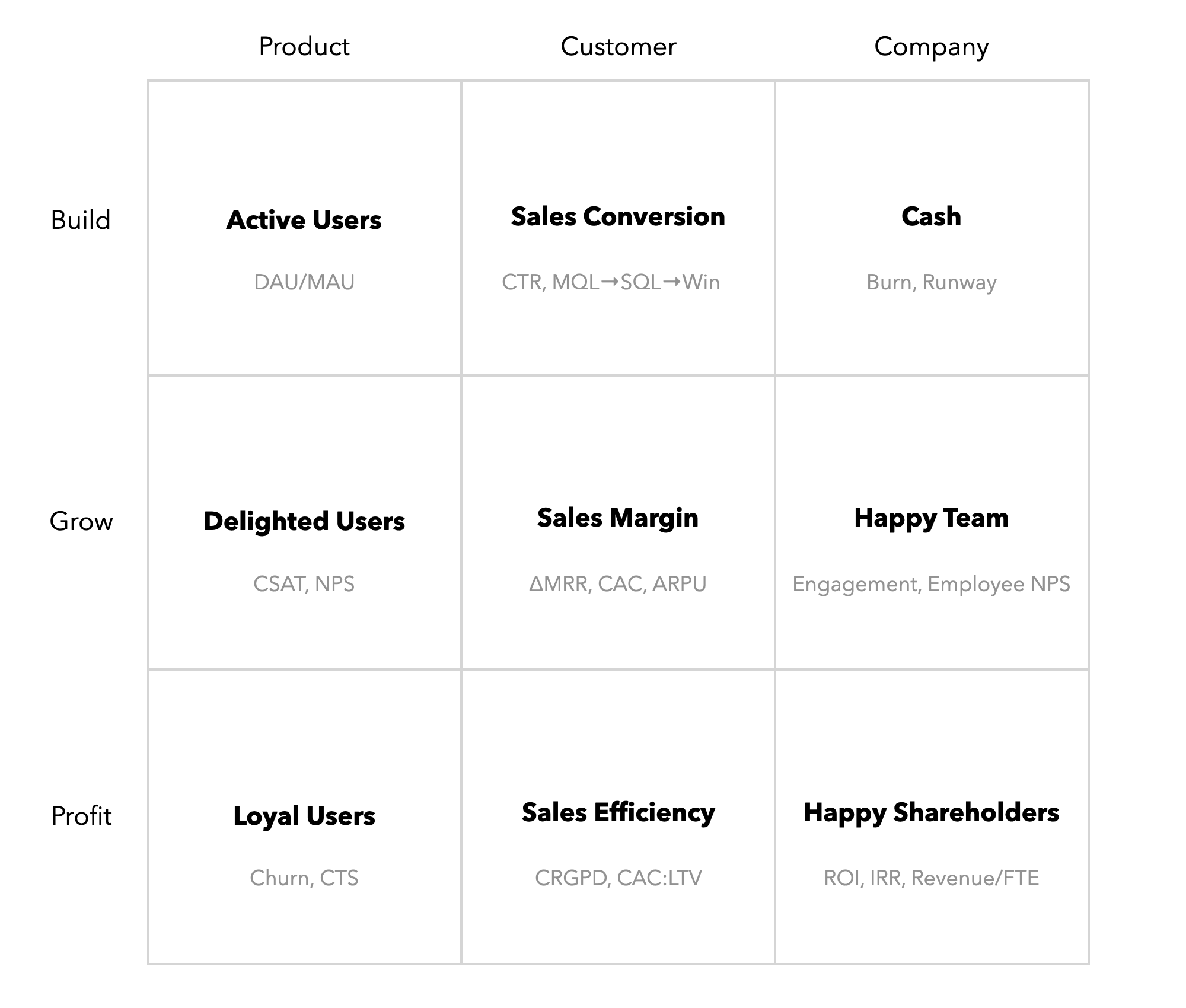There are so many different ways to measure a startup it’s easy to drown in metrics. How do we know what we should focus on? How do we separate the signal from the noise?
Here are two different ways to divide and conquer this problem…
Three machines
Consider the different people working on the team and the responsibilities they have.
There are broadly three specialities: 1
- Product - developing, maintaining and operating the product or service;
- Customer - marketing, selling, on-boarding and supporting customers to use the product or service; and
- Company - recruiting, retaining, running and (not least) funding the team that makes everything else possible.
Three phases
Alternatively, consider the progression of a startup from early-stage to successful mature business.
Again, there are broadly three stages: 2
- Build - developing a product that solves a real and valuable problem and attracting some initial customers;
- Grow - overcoming obscurity and promoting and selling the product to more and more customers; and
- Profit - doing all those things efficiently and ensuring that the amount we spend on each customer is relative to the amount we earn.
Nine intersections
We can use these two groupings to create a 3x3 matrix that helps us think about the important measures of success for each team at each stage.
What’s at the intersections?

We can work down each column in this framework to consider the progression for each area of the business…
Product team
The first job is to develop a product or service that solves a problem. Perhaps we stumble across that immediately, but more likely we need to work hard while customer numbers are small to understand if people are actually using what we’re building in the way we anticipated, and adjust accordingly. A common trap at this stage is to be overly influenced by what potential customers say they will do, only to later discover they don’t do that at all once we’ve built what they said they wanted.
As the number of customers grows we can start to segment, and understand what is attracting our best customers and also what the gaps are for customers we don’t retain.
Later, as we get beyond early adopters we need to pay more attention to things like customer churn and the cost of servicing each customer, so we can invest in the right areas.
We progress from measuring active users to measuring delighted users to finally measuring loyal customers.
Customer team
In the early stages we’re looking for initial customers who are willing to use the product right away, even though it’s only half built. We need to understand how customers move through our sales funnel - e.g. using free trials or a land-and-expand approach. To move beyond one-by-one sales we need to experiment with the different sales channels that are available and understand the costs associated with each.
We need to learn what generates growth. Perhaps existing customers spread the word for us, but more likely we need to buy it. Maybe there are also opportunities to increase the revenue we earn from existing customers.
Later, with the benefit of more time, we can track the lifetime value of different customer cohorts and use that detail to tune our sales process.
We progress from measuring sales conversions to measuring sales margins to finally measuring sales efficiency.
Company team
At the beginning cash is typically the most critical constraint. Either we need to ensure that the amount we’re spending is relative to the initial revenue we’re generating, or we need to raise external capital to fund the difference.
As the team grows, we need to focus on team culture (in simple terms, the things we do repeatedly) and make sure we’re attracting the right kind of people to fill the different roles we have and keep them engaged and happy.
Eventually we also need to consider how people who have invested time and money to create the business will get a return.
We progress from measuring cash flow to measuring team engagement to measuring shareholder returns.
Walk → Run → Fly
We can also work across each row in this framework to quickly identify the basket of metrics that are likely to be most important at each stage of the business…
In the beginning we measure user activity, our sales funnel and cash flows.
As growth accelerates we measure net promoters, net new revenue and cost-to-acquire, plus team engagement.
As the business matures we measure customer retention and churn, lifetime value (or, perhaps more usefully, average contract value) and return on investment.
We don’t need to drown. We can use these intersections to narrow our focus on the metrics relevant to our current age and stage. This lets us keep our heads above water and mature our approach over time.
-
The Three Machines by Brad Feld, January 2017. ↩︎
-
Lean Analytics by Alistair Croll & Benjamin Yoskovitz, specifically chapter 5 describes three phases:
- Product Development
- Customer Growth
- Unit Economics
They are themselves expanding on the stages of a startup from The Lean Startup by Eric Ries:
- Make something that is sticky,
- Then make something that is viral
- And then finally make something that generates revenue
Related Essays
M3: The Metrics Maturity Model
Use these simple steps to improve how we measure and report our progress.
How We Win
How well does your team understand your plan to win? When was the last time you wrote it down or said it out loud?
Anything vs Everything
How do we choose what to focus on, and have the conviction to say “no” to everything else?